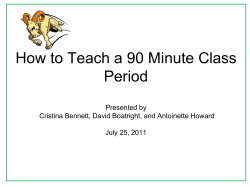
Running Records
Running Records Objectives • To review the components of the reading process • To promote participant awareness of Running Records as an assessment tool • To provide an opportunity to practice using Running Records • To facilitate discussion and reflection on the use of Running Records Components of the Reading Process Attitude/ Motivation Phonological Awareness/ Phonics Vocabulary Wide variety of texts Reading Fluency Comprehension PDST:2013 Key Messages • Running Records are an effective tool for assessing a child’s reading level • Running Records can be used for grouping children according to their instructional reading levels • Running Records are taken to guide teaching • Running Records are taken to capture progress Guided Reading “Guided reading is a procedure that enables teachers to support small groups of students who use similar reading strategies and who are able to read texts at a similar level” (First Steps Reading Resource Book pg. 20 – 22) What is a Running Record? • An assessment of the child’s reading ability using an appropriately selected piece of text • A Running Record gives you evidence of what the child is able to do, ready to learn and learning over a period of time • It requires observing and recording all behaviours to help determine the “thinking process” children are using to read a piece of text A broad range of assessment data Assessment in the Primary School Curriculum: Guidelines for Schools (2007) (Assessment in the Primary School Curriculum, NCCA, 2007) How to take a Running Record • Sit the child beside you at a table • Choose a piece of text appropriate for the child’s reading ability approximately 150 words long* • Observe the reading behaviours the child displays as he/she is reading • Do not teach during the Running Record • Praise the child for their reading Errors -V- Behaviours • • • • Substitution Insertion Omission Told • • • • Appeal Try that again Repetition Self Correction How to take a Running Record • Accurate reading • Substitution went want • Repetition (R) • Self-correction (SC) R went sc want • Omission very How to take a Running Record • Insertion little - • Appeal A sometimes • Told (T) thought • Try That Again T [ TTA] 11 Accurate Reading Substitution Self Correction Omission & Insertion two four black - early -- long -- Sounding Out Appeal A Mugs A eyes A twitch A licks A velvet Teacher Told Mugs T _____ tail T _____ twitch T ____________ breakfast T __________ favourite T Try That Again b-i-g big √√√ Repetition ____R_ big _____R_ eyes _____R_ hair __________R_ breakfast Give it a go! Scoring a Running Record 1. Count the number of words read 2. Count the number of errors made 3. Divide the number of words read by the errors made to give you a ratio 4. Convert this to a percentage to find out the child’s reading level Reading Level • 95% - 100% Easy • 90% - 94% Instructional • <89% Hard Brainstorm the Practical Application of a Running Record Interpreting Reading Errors • Readers use three different cues when reading 1. Meaning Cues (Does it make sense?) 2. Visual Cues (Does is look right?) 3. Structural Cues (Does is sound right?) Meaning Cues • This refers to the child’s ability to make sense of a book at the text, content and word level • The child brings prior knowledge to every book they read • If they are making meaning of the text, they think and evaluate what they read • If a child’s error makes sense in light of the background of the story, information from pictures and meaning in the sentence then the child is using a Meaning Cue (M) Visual Cues • Visual information is the way letters and words ‘look’. • Readers connect how words and letters look to the sound of words and letters, when they are reading • If the child’s attempt resembles the word in the text at all, they are using some component of a Visual Cue (V) Structural Cues • Children who use structural cues are relying on their knowledge of grammar and structure of language to make the text sound right • Using this knowledge, readers check whether or not the word or sentence sounds right • If the error made makes sense structurally then the child is using Structural Cue (S) Give it a go! • Analyse the running record you have completed for meaning, structural and visual cues Planning for the Classroom • Who? • How? • How often? • What children? • Consider the purpose? Key Messages • Running Records are an effective tool for assessing a child’s reading level • Running Records can be used for grouping children according to their instructional reading levels • Running Records are taken to guide teaching • Running Records are taken to capture progress
© Copyright 2025





















